

 The South African
The South African
Those who are sixty years or older and who have viewed the many paintings in the official Second World War art collection at the South African National Museum of Military History in Johannesburg may recognize three familiar faces - those of Bob Kershaw, Clive Peter and Barbara Palmer. To many, they were the pilot, the sailor and the nurse whose portraits were used in the famous South African stamp series issued by the Union Defence Forces (UDF) during the Second World War (1939-45).
The predominant idea behind the creation of the stamp series was to acknowledee the activities of the various branches of the UDF. It was suggested that Captain Neville Lewis, South Africa's first appointed war artist, should be approached to design the series.(1)
Neville Lewis (1895-1972) was born in Cape Town and studied fine art in the United Kingdom at the Newlyn Art School and the Slade School of Fine Art. During the First World War (1914-1918), he served in the British Army. Lewis established himself as a portrait painter of international recognition in the years between the two world wars. On 4 December 1940, he was appointed as the first of seven official war artists in the LDF. In the three years that he spent as a war artist, he travelled in and between South Africa and the battlefronts in East and North Africa and painted many important personalities, including Field Marshal Jan Christiaan Smuts, Viscount Montgomery of Alamein, Earl Alexander of Tunis, Air-Chief Marshal Lord Tedder and Major-General Dan Pienaar (GOC of the 1st South African Division).(2)
At the time that the request was made, Lewis was too involved with the war art programme to devote all his attention to this new project. Instead, he submitted five already completed portraits for approval for the series.
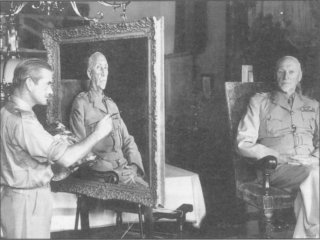
The artist at work. Capt Neville Lewis completes a portrait
of Field Marshal Smuts, 1941. (Photo: SANMMH)
The submissions were favoured by both the Postmaster-General and the Minister of Posts and Telegraphs of the time. According to Lewis, however, Smuts. who was Prime Minister of South Africa and Commander-in-Chief of the UDF at the time, vetoed the use of the portrait of the black soldier. This was very disappointing to Lewis, who considered the portrait in question to be the best of the five.(4) Eventually, only the portraits of the pilot, sailor and nurse were published. It is not known why that of the tank trooper was also omitted from the list.
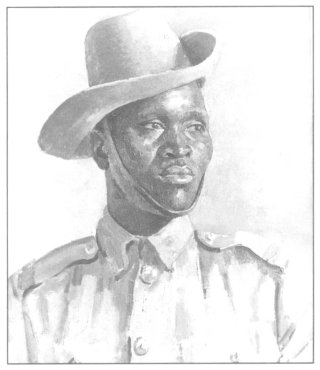
Soldier South African Native Military Corps
(Official WW2 Art Collection, Cat. No 1815)
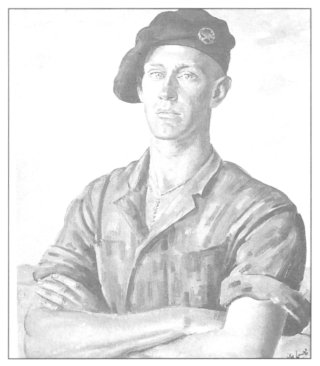
Trooper - South African Tank Corps
(Official WW2 Art Collection, Cat. No 1214)
The portrait of Clive Edward Peter was used to represent the sailor. Before the outbreak of the war, Clive Peter had trained in the Royal Navy Volunteer Reserve in East London. In September 1940, he joined the South African Seaward Defence Force, but was seconded to the Royal Navy, where he remained until the end of the war. He served as a Leading Signalman for practically the entire war, before being commissioned as an Acting Sub-Lieutenant in April 1945. One of the ships on which he served was the frigate HMS Nigella which docked in East London Harbour to be refitted during the war.(5)
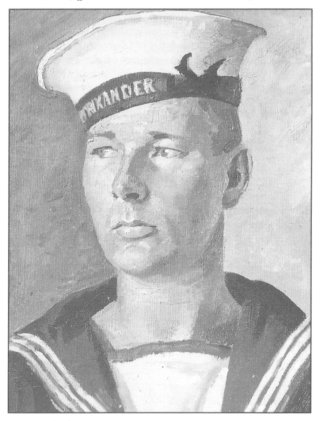
Sailor (Official WW2 Art Collection Cat. No 1924)
Barbara Palmer trained at Addington Hospital in Durban before the war. In 1940 she joined the South African Military Nursing Services and served for a period in South Africa at No 110 Military Hospital. It was while she was stationed there that Lewis produced the portrait. In 1941 she was transferred to the Middle East and served in turn at Nos 104,105 and 106 Military hospitals until 1944, when she returned home to marry.(6)
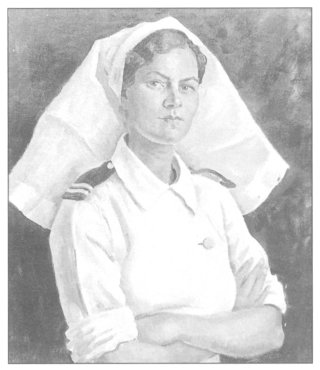
Nurse (Official WW2 Art Collection Cat. No 1833)
The third subject in the series was the pilot, Lieutenant Bob Kershaw, who in March 1941 became the first South African to be made a Companion of the Distinguished Service Order. He achieved this honour in East Africa, after he had landed under fire to rescue his flight commander, Captain Jack Frost, whose plane had been shot down. He had then flown with Captain Frost on his lap in his single-seat Hurricane for three-quarters of an hour before landing back at their base. Kershaw was recommended for the Victoria Cross for this deed. Later in 1945, he was also awarded the Distinguished Flying Cross for his courage and devotion to duty.(7)
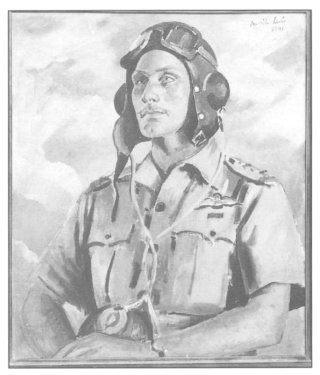
Lt R Kershaw, DSO, DFC
(Official WW2 Art Collection, Cat. No 1744)
The series proved to be very successful and the three portraits appeared both on the ordinary stamps, which were printed by rotogravure at the Government Printing Works in Pretoria, and on the bantam-sized stamps, which were produced later to conserve all available paper which was suitable for postage stamp printing. The denominations were as follows:(8)
The nurse - ld
The pilot - 1 1/2d
The sailor - 2d
The series remained popular after the war and made rare appearances on envelopes until December 1972, when they were finally withdrawn after all pre-Republic stamps in South Africa were demonetized.(9)
All three portraits used in the stamp series, as well as the two which were omitted, remain part of the official Second World War Art Collection housed at the South African National Museum of Military History. They are exhibited from time to time with other works from the collection in various exhibitions held both at the Museum and at other venues around the country. Just as the stamp series was produced during the war to commemorate the men and women who served our country, these portraits and the other paintings in the collection remain a lasting testament to the same cause.
References
1. Documentary video film: Visions of War, (Leephy Studios,
Johannesburg, 1986), Photographic Archives, South African National
Museum of Military History.
2. N P C Huntingford, The World War II Works of Neville Lewis, (SA
National Museum of Military History, Johannesburg. 1984), pp 4-6.
3. A N Lewis, Studio Encounters (Tafelberg, Cape Town, 1963), p 134.
4. Lewis, Studio Encounters, p 134.
5. File 920 - Peter C E: 'Personal correspondence'; File 769.56 - WW2:
Article in the The Daily News, 23 January 1975. Both files are kept
in the Archives of the South African National Museum of Military History.
6 Official World War II Art Catalogue, Cat No 1833, at the South
African National Museum of Military History.
7. Official World War II Art Catalogue, Cat No 1744, at the South
African National Museum of Military History.
8. J H Harvey Pirie, World War II Philately of Southern and Eastern
Africa (Africana Museum, Johannesburg, 1953), pp 15-16.
9. File 920 - Lewis A N: Article in The Cape Times, 6 January 1973, in
South African National Museum of Military History Archives.
Return to Journal Index OR Society's Home page
South African Military History Society / scribe@samilitaryhistory.org